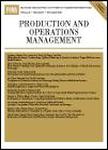-
作者:Xu, He; Yao, David D.; Zheng, Shaohui
作者单位:Huazhong University of Science & Technology; Columbia University; Hong Kong University of Science & Technology
摘要:We study an inventory system in which a supplier supplies demand using two mutually substitutable products over a selling season of T periods, with a single replenishment opportunity at the beginning of the season. As the season starts, customer orders arrive in each period, for either type of products, following a nonstationary Poisson process with random batch sizes. The substitution model we consider combines the usual supplier-driven and customer-driven schemes, in that the supplier may ch...
-
作者:Ibrahim, Rouba; Whitt, Ward
作者单位:Columbia University
摘要:Motivated by interest in making delay announcements in service systems, we study real-time delay estimators in many-server service systems, both with and without customer abandonment. Our main contribution here is to consider the realistic feature of time-varying arrival rates. We focus especially on delay estimators exploiting recent customer delay history. We show that time-varying arrival rates can introduce significant estimation bias in delay-history-based delay estimators when the system...
-
作者:Durango-Cohen, Elizabeth J.; Yano, Candace A.
作者单位:Illinois Institute of Technology; University of California System; University of California Berkeley; University of California System; University of California Berkeley
摘要:We study a Forecast-Commitment contract motivated by a manufacturer's desire to provide good service in the form of delivery commitments in exchange for reasonable forecasts and a purchase commitment from the customer. The customer provides a forecast for a future order and a guarantee to purchase a portion of it. In return, the supplier commits to satisfy some or all of the forecast. The supplier pays penalties for shortfalls of the commitment quantity from the forecast, and for shortfalls of...
-
作者:Kachani, Soulaymane; Shmatov, Kyrylo
作者单位:Columbia University; Columbia University
摘要:We address the problem of simultaneous pricing of a line of several products, both complementary products and substitutes, with a number of distinct price differentiation classes for each product (e.g., volume discounts, different distribution channels, and customer segments) in both monopolistic and oligopolistic settings. We provide a generic framework to tackle this problem, consider several families of demand models, and focus on a real-world case-study example. We propose an iterative rel...
-
作者:Baron, Opher; Berman, Oded; Perry, David
作者单位:University of Toronto; University of Haifa
摘要:Two factors that their influence on the demand has been investigated in many papers are (i) the shelf space allocated to a product and to its complement or supplement products and (ii) the instantaneous inventory level seen by customers. Here we analyze the joint shelf space allocation and inventory decisions for multiple items with demand that depends on both factors. The traditional approach to solve inventory models with a state-dependent demand rate uses a time domain approach. However, th...
-
作者:Baron, Opher; Milner, Joseph; Naseraldin, Hussein
作者单位:University of Toronto; Braude Academic College of Engineering
摘要:In this research, we apply robust optimization (RO) to the problem of locating facilities in a network facing uncertain demand over multiple periods. We consider a multi-period fixed-charge network location problem for which we find (1) the number of facilities, their location and capacities, (2) the production in each period, and (3) allocation of demand to facilities. Using the RO approach we formulate the problem to include alternate levels of uncertainty over the periods. We consider two m...
-
作者:Kraiselburd, Santiago; Pibernik, Richard; Raman, Ananth
作者单位:INCAE Business School; European Business School (EBS) University; Harvard University
摘要:Although, ceteris paribus, reducing lead times may be desirable from an overall system perspective, an upstream party (e.g., a manufacturer) may have strong disincentives to offer shorter lead times, even if this came at no cost. We consider a setting in which the downstream party has the ability to exert a costly effort to increase demand (e.g., through sales promotions, advertising, etc.) during the selling season, and compare two situations: one where there is zero lead time (i.e., all dema...

